+Search query
-Structure paper
| Title | High-Light versus Low-Light: Effects on Paired Photosystem II Supercomplex Structural Rearrangement in Pea Plants. |
|---|---|
| Journal, issue, pages | Int J Mol Sci, Vol. 21, Issue 22, Year 2020 |
| Publish date | Nov 16, 2020 |
 Authors Authors | Alessandro Grinzato / Pascal Albanese / Roberto Marotta / Paolo Swuec / Guido Saracco / Martino Bolognesi / Giuseppe Zanotti / Cristina Pagliano /  |
| PubMed Abstract | In plant thylakoid membranes Photosystem II (PSII) associates with a variable number of antenna proteins (LHCII) to form different types of supercomplexes (PSII-LHCII), whose organization is ...In plant thylakoid membranes Photosystem II (PSII) associates with a variable number of antenna proteins (LHCII) to form different types of supercomplexes (PSII-LHCII), whose organization is dynamically adjusted in response to light cues, with the CS more abundant in high-light and the CSM in low-light. Paired PSII-LHCII supercomplexes interacting at their stromal surface from adjacent thylakoid membranes were previously suggested to mediate stacking. Here, we present the cryo-electron microscopy maps of paired CS and CSM supercomplexes isolated from pea plants grown in high-light and low-light, respectively. These maps show a different rotational offset between the two supercomplexes in the pair, responsible for modifying their reciprocal interaction and energetic connectivity. This evidence reveals a different way by which paired PSII-LHCII supercomplexes can mediate stacking at diverse irradiances. Electrostatic stromal interactions between LHCII trimers almost completely overlapping in the paired CS can be the main determinant by which PSII-LHCII supercomplexes mediate stacking in plants grown in high-light, whereas the mutual interaction of stromal N-terminal loops of two facing Lhcb4 subunits in the paired CSM can fulfil this task in plants grown in low-light. The high-light induced accumulation of the Lhcb4.3 protein in PSII-LHCII supercomplexes has been previously reported. Our cryo-electron microscopy map at 3.8 Å resolution of the CS supercomplex isolated from plants grown in high-light suggests the presence of the Lhcb4.3 protein revealing peculiar structural features of this high-light-specific antenna important for photoprotection. |
 External links External links |  Int J Mol Sci / Int J Mol Sci /  PubMed:33207833 / PubMed:33207833 /  PubMed Central PubMed Central |
| Methods | EM (single particle) |
| Resolution | 3.8 - 13.1 Å |
| Structure data | EMDB-10865, PDB-6yp7:  EMDB-10866:  EMDB-10867:  EMDB-10868:  EMDB-10887: |
| Chemicals | 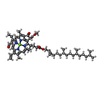 ChemComp-CHL:  ChemComp-CLA: 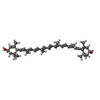 ChemComp-LUT: 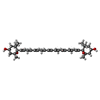 ChemComp-XAT: 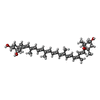 ChemComp-NEX:  ChemComp-LHG: 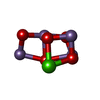 ChemComp-OEX:  ChemComp-FE2:  ChemComp-CL:  ChemComp-PHO:  ChemComp-BCR: 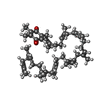 ChemComp-PL9:  ChemComp-SQD: 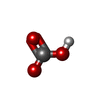 ChemComp-BCT:  ChemComp-DGD:  ChemComp-LMG:  ChemComp-HEM: |
| Source |
|
 Keywords Keywords |  PHOTOSYNTHESIS / PHOTOSYNTHESIS /  Cryo-EM / Cryo-EM /  photosystem II / High Light photosystem II / High Light |
 Movie
Movie Controller
Controller Structure viewers
Structure viewers About Yorodumi Papers
About Yorodumi Papers






